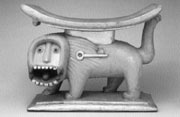ART FROM AFRICA: LONG STEPS NEVER BROKE A BACK
Seattle Art Museum, 100 University, 654-3100, $7 Feb. 7-May 19
IN A GALLERY of contemporary art, it would be the kind of work labeled “mixed media: fabric, bone, twine, leather.” So far as it goes, the description is accurate, but it leaves out the most potent aspect of the piece. It smells—no, make that stinks: of long-dried human sweat, of withered green things, rank animal musk, the dusty tang of blood.
The object in question is a kind of vest, made earlier this century by a hunter dwelling in Guinea on the great western bulge of Africa at the latitude of Costa Rica. But calling it a work of art is not polite fiction but simple fact. The man who made it considered it so, as did his tribe and tribes around. It was functional—worn—but the function was semantic: The vest was created to radiate meaning, not just to other human beings but to the creatures its maker hunted, to the very trees and creepers he hunted them among. And its smell is part and parcel of that meaning.
The hunter vests on view in curator Pam McClusky’s new exhibition of work from the Katherine White Collection of the Seattle Art Museum represent African art at its most divergent from Western notions. But if you can wrap your mind (and senses) around these pieces, you’ll be admitted to a privileged place from which to view others seemingly more ordinary, closer to our own idea of what art is.
You’ll discover, among other things, that for the people of black Africa a chair isn’t necessarily just something to sit on, a doorjamb doesn’t serve just to help hold the roof up. They often are deliberately contrived to signify something quite specific about the person entitled to sit and the status of the family living behind that door.
In the West, functional objects have mostly lost all such resonance, but so have the nonfunctional things we categorize as works of art. A Western door may be flanked by travertine pillars, just as a Western wall may be adorned by an oil painting. But both, to the extent they say anything at all, say most, “Geez, what a lot of dough these people must have!”
African objects can boast their possessors’ wealth and status, but they also help explain such things. And the person whose status they enhance is expected to live up to the privilege they afford. If you are going to sit on a stool supported by a carved lion, you had better sit like someone who shares the virtues of the king of beasts, because the throne will not share its power with someone weak, who slumps or fidgets—and without its power you may not be king much longer.
For this show, SAM has broken with most of the museological practices that normalize everything from Ming ceramics to mammals in formaldehyde into mute objets d’art. Gone are the chaste little labels with their names, dates, and recipes of ingredients. Instead, visitors seeking information about what they’re looking at will listen to the recorded voices of people who live today within the traditions that produced these objects yesterday.
African art implies action even when it’s static. On its home ground, a mask or statue is rarely seen except in motion, worn by a dancing figure or borne swaying in procession. At SAM, visitors will be surrounded by projections depicting the human environment that gives meaning to the pieces on show and derives meaning from them in return.
For those who want to edge closer to experiencing this material as it was meant to be experienced, SAM has performed a great service by inviting Robert Farris Thompson to recycle material from his long out-of-print masterpiece African Art in Motion in its catalog of the new show (Princeton University Press, $50). When you have read Farris Thompson’s descriptions of how posture and expression energize African carvings of the human figure, you’ll never again see anything primitive or crude in such work.
Two lessons emerge from this show and its manner of presentation. One is a lesson for McClusky’s fellow curators. These populist days, everybody pays lip service to education, outreach, revitalizing art by putting it in context. But contextualization rarely amounts to much more than tokenism: longer labels on the walls. But in our time, the great majority of stuff in museum vaults is as much in need of contextualization as any African mask. We cannot today understand what feelings and forces gave rise to a Madonna and child or a Japanese woodblock print without an effort of imagination, and the very museum environment, all cool chastity and dry presentation, tends to deaden imagination, not stimulate it.
The other lesson this show teaches is for us the viewers. How can we look at this work—created to define individuals to themselves and others, to confirm relationships, bind people together in common action and aspiration, fill the universe from the dirt beneath our feet to the sky above with meaning—and not feel how poor, how empty, we, the privileged inheritors of all the material treasure of the earth, have become?








